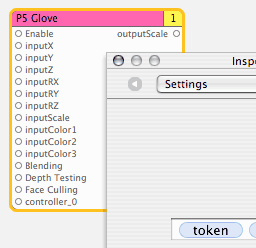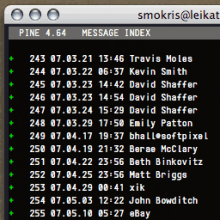Archive
ruori pure qc
Back when project ruori was working on PURE, I wrote several custom patches for Quartz Composer to enable us to use it to develop the controller software. Input came in the form of fifteen photocells, connected to the MIDIbox64 I constructed as an undergraduate project a few years ago. MIDI input entered Quartz Composer, was processed by a huge patch (going ten levels deep in macro patches in some places), and was output to:
Apple Remote Patch for Quartz Composer
I took Martin Kahr’s Apple Remote Controller Wrapper Class and built a Quartz Composer patch around it.
Leopard (10.5) includes a built-in Apple Remote patch.
Please see also kineme.net for Leopard-compatible patches.
Some notes:
- The events received from the Apple Remote are fairly strange to begin with.. You don’t simply get “key down” / “key up” events as I would have assumed, but instead get cooked events – for many of the buttons, holding the button down generates a different event than tapping it.
- My patch queues events, to ensure that each keypress is visible for at least one frame.
Steve Mokris is a developer at Kosada, Inc.
Review: Bower VL46TC Fisheye with Macro Lens Extension

- “Titanium” (I think it’s actually aluminum)
- “High Resolution” (It’s a glorified magnifying glass, so it unavoidably blurs around the edges.)
- “Digital” (This one baffles me. It contains no electronic parts whatsoever.)
- “AF” (AutoFocus. Again, contains no electronics, or even moving parts. My lens’s autofocus still works when this is attached, for the most part. However, under some circumstances, the attachments confuse the camera and necessitate manual focus.)
- “To fit : […] ALL FINE SLR CAMERAS.”
OK, now the fun stuff: pictures!
The Secret Life Of a Patch

Being open source, their projects and products are often enhanced by the contributions of others. These contributions often come in the form of a “patch” – a file that tells the computer what to change in the source code to add the contribution.
Advanced custom Quartz Composer patch development documentation
In addition to writing the inspector panels for custom Quartz Composer patches tutorial, I spent this weekend writing up some advanced custom-patch-development documentation and posted it on QC Wiki:
Steve Mokris is a developer at Kosada, Inc.
How to make inspector panels for custom Quartz Composer patches

Please see kineme.net for Leopard-specific informations.
Project Hayate - Prolonging the Inevitable - Part 1
Author’s Note: Forgive this preamble I promise that they’ll be juicy links and google page rank increases in Part 2.
After my October escapade in Boston – with a brief layover at Yon Reptile Campaign – Lifeâ„¢ decided to shine a ray of hope in my general direction, after Thanksgiving. However, quick to grant me access to enough income to pay rent, Lifeâ„¢ viciously raped my ATI Radeon 9800 Pro, and I was unable to use MPlayer to play movies, use GL to play games, or whatever else we non-Apple people do with our video cards.
Keybindings in Mac OS X 10.4's Terminal.app

I use PINE as my email client.
“Why are you living in the late 1970s?” you ask.
But I’ll refrain from answering that question for now. And I’ll even refrain from correcting you in that PINE wasn’t available until 1989.
And, so, in fighting the ongoing war against email, I tend to spend a lot of my day interacting with Mac OS X’s Terminal.app. I SSH into one of our Fedora Core Linux servers and run PINE there.
The default keybindings used by Terminal.app leave a bit to be desired, however
Xcode Template for Custom Quartz Composer Patches

Frustrated with the tedium of going through all the Xcode project files in a text editor and manually replacing all of the identifiers and filenames when creating a new Quartz Composer Patch, I decided to finally figure out how to create a new Xcode template.
Malus Sylvestris Migration, Part 2

At the point where I left off, I figured I was pretty good to go. I had Xcode installed, so I grabbed the Thunderbird 2.0b2 source so I could compile it – hacking on Thunderbird is one of my soon-to-be all-encompassing projects.
Divining Oracle's TCO

There are many options in the database world. Many solutions for all kinds of work loads, and solutions for all kinds of financing models.
Oracle, a database vendor, is pretty tight-lipped about its financing. Nowhere on the website is price listed. Today, we managed to breach this obfuscation. We had to call them.
Licensing for Oracle is offered on a per-CPU basis for the database servers, and on a per-machine basis for the user clients. They weren’t clear as to what constitutes a CPU – does Hyperthreading count as 2 CPUs? does Dual-Core?
Either way, the price per CPU is $40,000.
Per client machine, the license cost is $800.
Plus a support contract.
So, instead of spending well over $200,000 on this…
We’re replacing one of Kosada’s consulting clients’ ancient Oracle servers with one running PostgreSQL.
Cross-compiling on Malus Sylvestris
After working my way through most of the migration to Mac, I came across a common problem for multi-platform developers like myself. The problem is the creation and use of applications targeted for another platform. For example, using a Linux compiler to develop Windows applications, or using an OS X compiler to develop Linux applications.
This is a fairly common problem, and also fairly simple to solve. The resultant tool kit is referred to as a Cross-Compiler, because is crosses platforms, and it compiles source code into target code. For Linux, my cross-compiler of choice was created and maintained by SDL, and can be found here. This allowed me to write Windows programs without needing to actually run Windows. Since both Linux and Windows were my complete set of frequented platforms, that sufficed. Now, however, one more platform has entered the mix.
Malus Sylvestris Migration, Part 1

And there’s a pretty steep curve attached to switching Operating Systems. This is especially the case when you’ve used a very dynamic, customizable operating system like Linux the majority of the time. In this article I’d like to address some of the issues noted, less than 12 hours after I’ve opened the box, to perhaps help others get reoriented.
For much of my computer-using life, I’ve been an Intel-based computer user. This means that I grew up on


 I made a pair of patches to allow Quartz Composer to directly interact with the Phidget InterfaceKit
I made a pair of patches to allow Quartz Composer to directly interact with the Phidget InterfaceKit 
